Out of retirement and into the frying pan — developer Dan Catalfumo is back
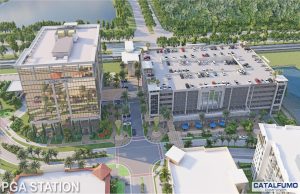
An “iconic” eight-story office building, left, and 1,066-space parking garage along with a 396-unit apartment building, right at bottom, and adjoining garage are proposed by developer Dan Catalfumo southwest of PGA Boulevard and Alternate A1A. (Courtesy Dan Catalfumo and SPINAOROURKE + Partners of West Palm Beach)
Palm Beach Gardens developer Dan Catalfumo is back.
When last we saw him 10 years ago, the city’s most influential builder since John D. MacArthur had been stripped of his real estate empire under a mountain of debt.
He invested in a chicken deboning business and manufactured a seatless bicycle. He was spending time away from Palm Beach Gardens at second homes in South Carolina and Costa Rica.
Now, he’s pitching a $200 million legacy project in Palm Beach Gardens.
He wants to build up to 750 apartments and an “iconic” eight-story office building on land he initially developed but lost to foreclosure.
He no longer has the 350-employee workforce that made him the county’s biggest builder or the portfolio of developable properties that made him central to Palm Beach Gardens’ future.
But he’s positioned to leave his mark with an ambitious proposal called PGA Station that would refashion an underused center into a major hub on the city’s most prominent commercial artery.
“This,” he said, “should be our legacy for 50 years to come.”
Retirement, said Catalfumo, 65, did not suit him.
“I was bored. I didn’t have anything to do. I don’t play golf. So …”
So, in April 2019, Catalfumo brought $17 million to the table, with construction partner and longtime friend Bob Rawe, to buy three properties from BBX Capital Asset Management, the same lender that won a $44 million foreclosure judgment against Catalfumo just eight years earlier.
The BBX debt and others, once totaling more than $100 million, are long gone, Catalfumo said, a statement reflected in court records.
“You write them a check, they go away,” he said. “Every person was paid 100 cents on the dollar. My mom and dad gave me a clean name when I was born and I have a clean, spotless name still. I owe nobody a penny. I wrote the checks to satisfy everyone. It did not change my lifestyle. Pour the wine, I drink.”
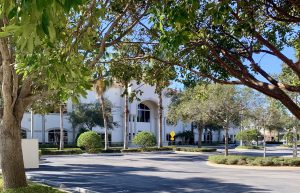
The Robb & Stucky building in the former PGA Design Center is slated for the wrecking ball as part of Dan Catalfumo’s proposed PGA Station. (Joel Engelhardt photo)
‘Iconic’ offices
With the land buy, Catalfumo took a commanding role in the revival of a mostly vacant and forgotten 30-acre corner of Palm Beach Gardens known as the PGA Design Center.
Erected in 2004 on former MacArthur Foundation land, the design center just west of Legacy Place and south of PGA Boulevard gave space to the booming furniture industry during a seemingly endless real estate expansion.
While the La-Z-Boy showroom off of RCA Boulevard remains, the huge two-story Robb & Stucky showroom is destined for the wrecking ball. The building, vacant for 10 years, would make way for a 396-unit apartment building, with the potential to go up to 750 units, and a 608-space parking garage.
Catalfumo is partnering with the Richman Group, which has built apartment complexes throughout Florida and has an office in West Palm Beach, to build the residential.
But the centerpiece of Catalfumo’s plan submitted to the city in September is the 200,000-square-foot office building on the vacant 7 acres along the railroad tracks at the foot of Design Center Way. It would include a 1,066-space parking garage with 100 spaces set aside for Tri-Rail if it comes.
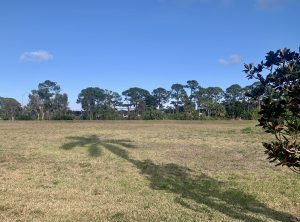
The office site is along the railroad tracks in developer Dan Catalfumo’s proposed PGA Station. (Joel Engelhardt photo)
Catalfumo in consultation with Tri-Rail is proposing to build walkways and drop off areas to serve the proposed train station separately from the entry to the office building.
He promises a Class A building with interiors undisturbed by columns, allowing for open, 25,000-square-foot floor plans.
He also would retrofit an existing two-story, 20,400-square-foot building, formerly home to Robb & Stucky’s outdoor collection, where he has rehung the Catalfumo nameplate.
Gone will be the Mediterranean-style architecture of the existing buildings. The new buildings, Catalfumo promised, will be “clean and crisp.”
The architect for the office building, SPINAOROURKE + Partners of West Palm Beach, describes it this way in Catalfumo’s application to the city:
“The project’s architectural style is Contemporary modern. The overall project design is straightforward in its layout and the style reflects that with clean crisp forms derived from the simple massing.”
Catalfumo expects to bring the project before the city’s Planning, Zoning and Appeals Board in two months, however the city has not yet scheduled a hearing. City Council review would follow.
While commuter rail in north county is still years away, the city encourages apartments near the rail line to generate density within walking distance of the proposed train station.
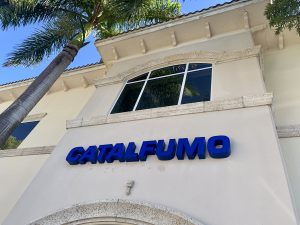
Developer Dan Catalfumo has set up offices in the former Robb & Stucky outdoor furniture center at the center of his proposed PGA Station development. (Joel Engelhardt photo)
The proposal initially calls for 396 units, which is 13.4 units per acre. With bonuses for workforce housing, environmentally friendly design and ground-floor retail, Catalfumo is seeking to ultimately be allowed to build 25 units per acre over the 30-acre site, or 750 units.
He is seeking five waivers, including 48 fewer residential parking spaces, saying shared parking with the office parking garage and existing parking will make up for it. Two waivers would let him erect more signs on his buildings than allowed and two would allow landscape reductions, in one case to accommodate the train station.
The Robb & Stucky demolition would happen first, followed by construction of the apartment building. The office building would come later.
Owned the heart of the Gardens
While Catalfumo has been behind many large and important buildings throughout Palm Beach County — such as Office Depot’s Delray Beach expansion, West Palm Beach City Hall and adjoining library and the Port of Palm Beach cruise terminal — he has had more impact on Palm Beach Gardens then anywhere else.
Twenty years after the death of the city’s founder, insurance magnate John D. MacArthur, Catalfumo took up the mantle to shape all four corners along what is arguably the city’s most important intersection, the crossing of PGA Boulevard at Alternate A1A near the Gardens Mall.
He spent about $50 million to buy large undeveloped sites on all four corners in 1999, when MacArthur’s Chicago-based foundation sold off its 14,808 acres, much of it centered in Palm Beach Gardens and held off the market for years after MacArthur’s 1978 death.
And until the Great Recession of 2008 hit, Catalfumo made money selling or developing the land.
First came the PGA flyover, allowing PGA to flow over the Florida East Coast Railway tracks and Alternate A1A, a $26 million state construction project cleared only after the state agreed to pay the MacArthur Foundation $12 million for 35 acres needed for drainage and right of way.
Then Catalfumo began marketing the four corners around it, properties that would grow into Downtown at the Gardens, Legacy Place, the Design Center and a Florida Power & Light campus.
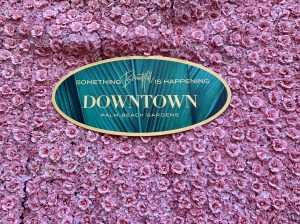
Downtown Palm Beach Gardens, originally known as Downtown at the Gardens, grew out of MacArthur Foundation land bought by Dan Catalfumo. (Joel Engelhardt photo)
Catalfumo’s $10 million investment in what would become Downtown at the Gardens and a hotel nearly doubled in value when he sold them in 2002 and 2003 for a combined $19.3 million, deeds show. He spent $15.2 million on PGA Boulevard sites on the east side of the mall, bringing in at least $26 million.
He paid $12.9 million for land that became Legacy Place, selling off one portion for a 382-unit apartment complex for $6.7 million in 2002 and, two years later, the commercial section for $25.3 million, records show.
He paid $4.5 million for the 30-acre Design Center site south of PGA and west of Alternate A1A and began selling parcels in 2007, including one for his corporate headquarters. The northern portion of the site began to take shape with $9 million in sales in 2008, just as the economy began its collapse.
In 2011, a circuit court judge ruled he owed BankAtlantic $44 million for loans against the property. A successor bank, BBX, pursued the case vigorously, saying in court papers that Catalfumo had transferred millions to a Cayman Islands bank account. In a June 2013 press release, BBX said Catalfumo agreed to settle for $25 million upfront, $5 million later and forfeited property valued at $14 million.
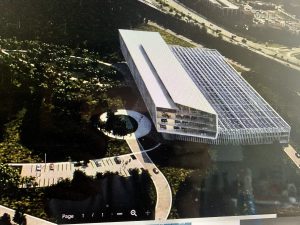
Perkins + Will of Coral Gables designed this aerodynamic six-story office building for FPL. It is rising just west of the Gardens Mall on Kyoto Gardens Drive.
“I paid CASH 100% on the dollar,” Catalfumo said.
Lenders also seized the fourth corner, the future FPL site, where Catalfumo confirmed that he had squirreled away a 4.25-acre parcel under the name Spearfisher Partners. The lender sold the rest of the 86-acre site to FPL in 2011. But Catalfumo held on to his piece until March 2018, when FPL paid $4.89 million for it.
In 2019, years after the lender lawsuits were closed out, Catalfumo paid cash when he bought three key Design Center properties back for $17 million. On the day of the closing, BBX extended him and partner Bob Rawe a $4.6 million loan, mortgage records show.
He and Rawe quickly built the second building in the center for TBC Corp., dubbed TBC South, a 60,000-square-foot office building at 4260 Design Center Drive.
That left two parcels, one containing the long-vacant Robb & Stucky buildings, the other a blank slate along the railroad tracks.
Now with five employees including his 26-year-old son, not 350 workers as in the past, Dan Catalfumo is moving forward on what he calls his legacy.
“This is full-time. Fourteen hours a day,” he said. “This is the new wave of the future.”
Thank you for reading. You may also want to check out Joel’s recent PBGWatch posting on the status of plans for a Tri-Rail commuter line in north county. Joel wrote and edited stories at The Palm Beach Post for nearly 30 years before departing in December 2020. He lives in Palm Beach Gardens and welcomes your comments and news tips at JoelOnGardens@gmail.com.
Why are workers chopping down oaks on a key Gardens road?
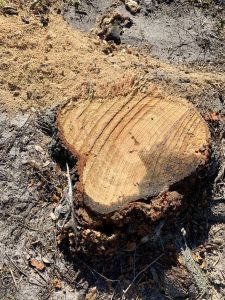
One of about a dozen stumps left after workers building the FPL office center on Kyoto Gardens Drive chopped down trees lining the road to make way for a road realignment.
Why are workers chopping down oak and palm trees along Kyoto Gardens Drive, that great short cut to the Gardens Mall from Military Trail?
It’s all part of the massive plan for the new FPL office headquarters taking shape along Kyoto Gardens just northeast of the I-95/PGA Boulevard interchange.
The plan for the $67.9 million construction project calls for moving a road.
Little-known RCA Center Drive, which runs north from RCA Boulevard and under PGA Boulevard, intersects with Kyoto Gardens Drive too near the FEC Railway tracks to allow a stoplight there.
And even though Florida Power & Light Co.’s preliminary studies showed the new intersection wouldn’t immediately generate enough traffic to justify a stoplight, FPL is spending the money now to move the road about 85 yards to the west.
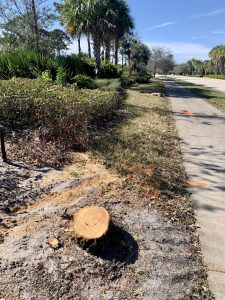
The stump of one of about a dozen live oak trees removed from Kyoto Gardens Drive in Palm Beach Gardens during construction of FPL’s new office building.
That means chopping down live oaks along Kyoto. A recent visit revealed seven new stumps west of RCA Center Drive and five east. It also means taking out some of the foxtail palms and hedges that decorate the roadway median.
Traffic engineers will conduct studies after the six-story office building opens in 2022 to up to 1,000 employees to see if enough cars line up at the newly rebuilt intersection to justify a signal.
In the meantime, FPL contractors are moving the road.
Workers are ripping out the concrete medians, tearing up sidewalks and chopping down the trees, many planted in the past five or six years. On Jan. 11, an earth mover in the median slowed traffic in one eastbound lane. In the other, a Mercedes-Benz crunched into the tailgate of a Toyota Tundra blocked traffic.
The new intersection will have a second northbound left turn lane and more room for cars to line up to turn but until it meets county stoplight criteria, stop signs will rule.
The sidewalk along Kyoto Gardens will be 12 feet wide instead of 5. That means ripping up more landscaping lining the road. There’s already been some clear-cutting behind the landscaped hedge line planted a few years ago by FPL but it’s not clear if those hedges will be removed. FPL did not return calls Thursday and Friday requesting comment.

Perkins + Will of Coral Gables designed this aerodynamic six-story office building for FPL. It is rising just west of the Gardens Mall on Kyoto Gardens Drive.
Stunning new building
FPL’s new building — that long, low-slung concrete structure rising now on the 86-acre site east of Military Trail — could be a stunner.
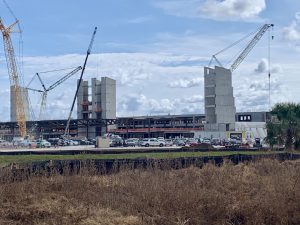
FPL’s six-story office building, part of a $67 million construction project, is rising just northeast of Interstate 95 and PGA Boulevard, west of the Gardens Mall.
Built to withstand Category 5 hurricanes, drawings by architects Perkins + Will of Coral Gables show a sleek modern design that looks like an airship dropped into a forest clearing. The top four floors, which house the offices, seem to float over the bottom two floors, devoted to a cafeteria, workout rooms and other large meeting space.
The building sits south of a berm, already constructed, and dominates the view across the lake from the Kyoto Gardens bridge east of the Trail. It can be seen from southbound Interstate 95 and it’s southern face dominates the view on the westbound PGA Boulevard exit ramp off of northbound I-95.
Saving some trees, clear-cutting others
FPL previously cleared the entire site of non-native trees, saving pines and sabal palms that have dominated the property for decades, although thinned by a March 2017 fire.
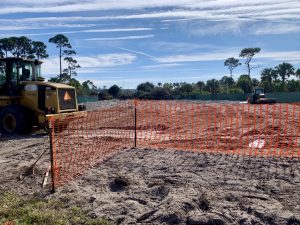
Workers cleared a path for the new RCA Center Drive, which is being rebuilt about 80 yards to the west so that a stoplight can be added some day as part of the FPL office building site.
Moving the road means more clear-cutting of native trees, which took place the week of Jan. 11, to forge the road’s new path.
Another path has been cleared through the forest on the southern perimeter, just below the elevated on-ramp to southbound I-95. The path will be paved for an internal perimeter road emptying onto RCA Center Drive. The main entrance is off of Kyoto.
Construction began in July, with building permits issued in 2020 showing an estimated cost of $51.5 million for the six-story building, $13.5 million for the three-story parking garage and $2.8 million for road work.
Catalfumo built the road
The property, long held by the late insurance magnate John D. MacArthur, went to his foundation after his 1978 death. The Chicago-based board sat on it for decades before selling it to Dan Catalfumo as part of its liquidation of its north county holdings in 1999.
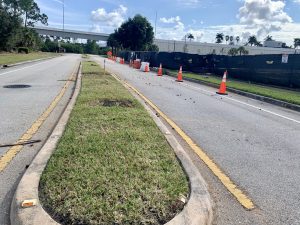
Workers took out palms and hedges from this median along RCA Center Drive, which is being rebuilt about 80 yards to the west so that a stoplight can be added some day.
To get the rights to turn the vacant property and another nearby tract into a commercial center, Catalfumo partnered with the city to build and landscape Kyoto Gardens Drive and RCA Center Drive in 2007. Building the roads, which included the rail crossing at Alternate A1A, cost about $5.6 million. The city kicked in about 40 percent because it wanted Kyoto to be four lanes instead of two.
But the economy went south and Catalfumo never built planned hotels, office buildings and stores on the huge site just west of the Gardens Mall. The developer lost the land to lenders.
FPL paid $24 million in 2011 for all but 4.2 acres, which it bought in 2018 for $4.9 million.
In July 2013, the city gave the Juno Beach-based power company the right to build nearly 1 million square feet of office space on the site.
Landscaping, some of which now will be removed, went up along the site’s perimeter after that.
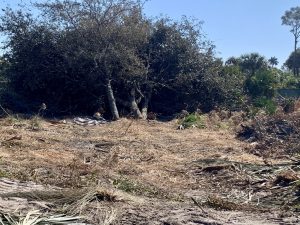
Workers stacked dead oak trees along Kyoto Gardens Drive during the week of Jan. 11 at the FPL office building construction site along Kyoto Gardens Drive.
Plans show FPL intends to replant foxtail and sabal palms, live oak 12 to 18 feet high and even South Florida slash pines in the medians, along the roadside or throughout the property.
Joel Engelhardt wrote and edited stories at The Palm Beach Post for nearly 30 years before departing in December. He lives in Gardens not far from the FPL office building site, known as PGA Office Center. He tried for two days to get FPL to return his calls to get its take on the tree-clearing. Not only would they not return his calls, they wouldn’t tell him the name of the appropriate spokesman for the project. You can email him at InTheGardensPBC@gmail.com.

